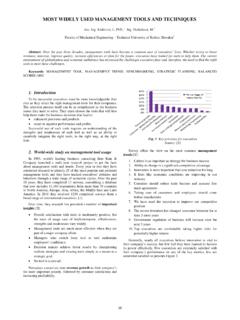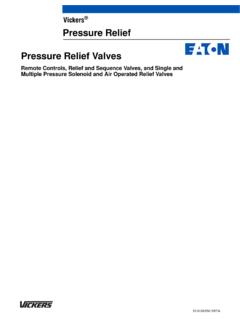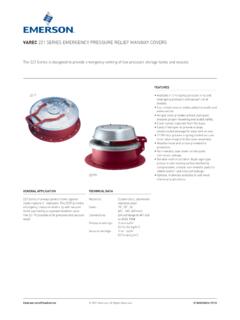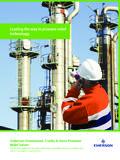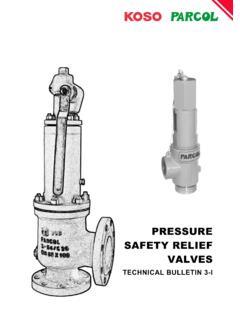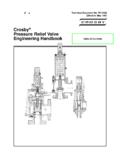Transcription of TROUBLESHOOTING FOR RELIEF VALVES USED IN …
1 TROUBLESHOOTING FOR RELIEF VALVES USED IN HYDRAULIC SYSTEMS Prof. Dr. M. Sc. Pancar Yasar1, Assoc. Prof. Dr. M. Sc. Ergur H. Sevil1 Faculty of Mechanical Engineering Eskisehir Osmangazi University, Eskisehir1, Turkey. Abstract: This study relates to the description of a RELIEF valve briefly and TROUBLESHOOTING due to pressure rise in hydraulic system. In any hydraulic system, it is essential to limit the maximum pressure generated by the constant displacement pump. For this purpose, usually pressure RELIEF valve is used and pressure across the RELIEF valve can be balanced. Many of the failures in a hydraulic system show similar symptoms such as, a gradual or sudden loss of high pressure , resulting in loss of power or speed in the cylinders. Due to possible malfuntions, the cylinders may stall under light loads or may not move at all.
2 Often the loss of power is accompanied by an increase in pressure which must be taken away by a RELIEF valve. Keywords: TROUBLESHOOTING , RELIEF VALVE, pressure -SENSITIVE VALVE, HYDRAULIC SYSTEM. 1. Introduction It is believed that the French scientist Denis Papin was the inventor of the safety valve at the end of the seventeenth century. The safety valve was kept closed by means of either a spring or a lever and a movable weight; sliding the weight along the lever to regulate the pressure . Some believe that, Papin was only the inventor of some improvements and that safety VALVES were already being used some 50 years earlier on a steam digester designed by Rudolf Glauber, a German-Dutch alchemist. Timothy Hackworth developed an open-ended safety valve for the steam trains and boilers that were first being built around 1830 when the starting of the safety valve designs as we use today [1].
3 Hydraulic systems are used in so many automatic machines. It is equipped with a pressure RELIEF valve to maintain the operation pressure of the system at a pre-determined level. RELIEF valve protects the hydraulic pump and in turn the prime mover from overload quickly in case the system is exposed to overpressure. That s why, characteristics of such a valve like the other system components are very important in designing the hydraulic system. The basic pressure RELIEF valve is dynamically undesirable due to relatively low viscous damping. This kind of valve provides low damping during upward movement of the RELIEF valve arbor [2]. pressure RELIEF VALVES used in hydraulic systems are spring-loaded VALVES designed to open and relieve excess pressure , then immediately close, preventing any loss of flow of fluid after normal conditions have been renovated [3].
4 They are designed and manufactured to act as a safety measure in pressurized liquid system. The RELIEF valve is a device utilized to divert excess pressure (sudden surges) in the discharge side of the pump into the suction side. Generally, these changes are so rapidly and of such magnitude, that the pump operator can not correct quickly enough. The properly set and maintained RELIEF valve can make these corrections for the operator [4]. The pressure RELIEF valve shall safely control increase in pressure by venting the pressurized liquid from the location. Another application is to protect equipment from overpressure. The VALVES are generally back- pressure dependent , so can be discharged to atmosphere easily. Once a valve has discharged, replacement is usually adviced, as the set pressure can no longer be guaranteed.
5 It is recommended to have a RELIEF valve pressure setting at least 25% higher than the maximum system operating pressure . One must be sure that set pressure should not be higher than the design pressure of the hydraulic system [5]. 2. Description of RELIEF VALVES Design A historic introduction to the pressure RELIEF valve evolution leads to the definition of the best performance characteristic of pressure RELIEF VALVES . The salient features of the valve's best performance characteristic as a combination of the valve best dynamic performance and the valve best discharge capacity and factors leading to distortions of the best performance characteristics [6]. RELIEF VALVES are classified in two types. In the direct acting type, the pressure to be relieved acts directly on the fluid regulating element. This type is commonly employed in systems with relatively low flow rates.
6 For high flow rates, a pilot operated type is commonly employed. In this type the pressure to be controlled acts on a pilot. As soon as this pilot allows flow, the pressure difference across the main regulating element becomes large enough to provide a force. It causes the valve to open rapidly because the spring controlling the main element is light. A RELIEF valve may be installed wherever there is a need to protect a probably the most common application. It would be protecting a pump against an excessive pressure rise when the motion of an actuator or motor becomes blocked. Although the load may be abnormal, actuator motions are often blocked deliberately, for example in a clamping application [7]. Pump protection circuit with RELIEF valve [10] The function of the RELIEF valve is to limit the maximum pressure that can exist in a system [8].
7 Under ideal condition, the RELIEF valve should provide alternative flow path to tank for the system fluid while keeping the system pressure constant. There are two types of VALVES that are commercially available such as, direct and pilot type (9). 3. Types of RELIEF VALVES Direct Acting Type It is usually a poppet, but other geometries such as a ball or a spool may be encountered. During normal system operation, the regulating element is held in a fluid blocking position by a spring. If the system pressure reaches a preset value, the force on the regulating element will equal the spring preload force. This is called the cracking pressure . Further, increase in pressure will cause movement for the regulating element from its fluid blocking position. Then it allows fluid to flow to the system reservoir [11].
8 Pilot Operated Type Element can be quite small because this pilot is only required to pass a small flow in a hydraulic circuit (see Figure 2). During the normal closed condition of the valve, there is no flow through the orifice in the main regulating element, so there is no pressure difference across the main element. Thus, the main element can be held in a closed position by a light spring [11]. 19 Basic types of RELIEF VALVES for different operations [5] 4. Operation of RELIEF VALVES in Hydraulic Systems The machine tolerances are critical and even a small amount of dirt can cause the RELIEF valve system to malfunction. A good preventive maintenance program is essential to prevent the problems in RELIEF valve system. It is important to realize that for the RELIEF valve to function properly, the discharge pressure should be at least 3-4 bar greater than the suction or incoming pressure .
9 If not, the RELIEF valve opens but the fluid will not be able to flow from the discharge to the suction area. It is a common fallacy of some pump operators to think the installed RELIEF VALVES protect them under all conditions. Normal RELIEF valve systems cannot relieve discharge pressure below the incoming or suction side pressure . Surges such as those encountered in a relay operation, if not controlled, it will be transmitted to the discharge side of the pump. If companies get involved in relay operations over 3 bar, a suction side RELIEF valve must be installed [12]. These are usually a one-piece unit (entirely separate from those previously discussed) in which pre-settting the pressure by adjusting a spring-loaded valve. When the pressure rises above the setting level, the valve opens and dumps the fluid to the tank. This continues up to the pressure drops below the preset pressure .
10 Without a suction-type RELIEF valve you are risking the possibility of excess pressure cracking the pump body or, even worse, the inability of your engineer to be able fully to control discharge pressure . A conventional pressure RELIEF valve is to be designed to open at a preset liquid pressure . A spring exerts a force on a valve seat via a piston assembly. At the set pressure , the piston begins to lift resulting in a small amount of flow through the valve and the pressure force. This force acts on the piston that increases importantly, and overcomes the spring force. The imbalance of forces cause the valve to fully open. By design, the difference in pressure from the valve set point to the fully open condition is no more than 10 %. The valve then re-closes at a pressure where the spring force overcomes the piston force. Under normal system operating conditions, the pressure at the valve inlet is below the set pressure .

